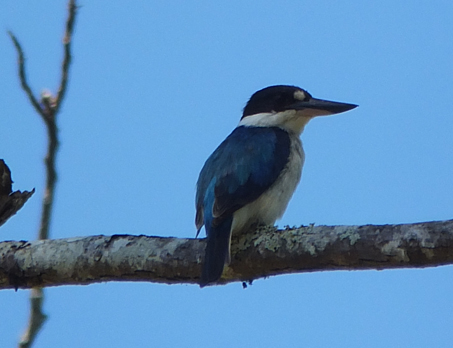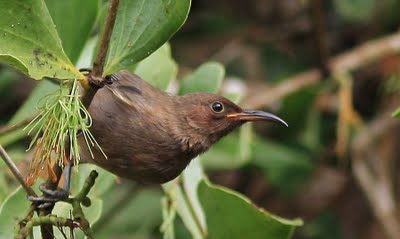| WILDWATCH: by ANNE WILKINSON This mid-spring is a season of temperature contrasts. The wonderfully cool early mornings are replaced with baking days. Often in the afternoon the wind springs up, drying any moisture if we were lucky enough to get a shower, and sending leaves and even branches tumbling to the ground. |
| Like the birds, here at Wildwatch we relish the very early mornings with their wonderful cool stillness when it is so pleasurable to work in the garden or in the forest. And there is a lot to do, especially in the forest. In the spaces opened by Cyclone Yasi weeds have proliferated. One severe nuisance is Singapore daisy which is pretty but also greedy as it mounds, climbing quickly over everything and even snaking up trees. |
Then there are the huge vines which will apparently succumb when cut but whose roots spread underground to shoot and engulf other trees. A problem with not removing these monsters is that they can not only strangle trees but can become so heavy when full of water that they bring the host trees crashing to the ground.
A classic case was a remnant scrub called Wingham Brush in New South Wales where a few years ago a spectacular, strong-growing, exotic vine called cat’s claw climber became so rampant it threatened to bring down almost all the trees in the tiny reserve. Only the efforts of local volunteers saved this small, but locally beloved patch of bush.
| But working out in the forest in the early morning cool with the birds flitting through the branches and a host of tiny butterflies and other creatures around is not only pleasant but interesting. This morning I was “buzzed” by a pair of dusky honeyeaters. It was already becoming hot and whether I was in the centre of a territorial battle or whether I was the cause of the problem I’m not quite sure. I watched them settle on a nearby branch. Their little beaks were open as if they were panting. |
At this time of year birdbaths and water dishes are important and certainly appreciated by wildlife in the garden. These always need to be close to cover, for example, thickly leafed bushes or undergrowth, so that small birds can feel safe as they drink.
This is of course a busy time for many birds which currently have the added responsibility of raising their young.
It is also a time when many people frantically call to ask what to do about baby birds they find on the ground which appear to have fallen from the nest or been abandoned by their parents.
Often, this is far from the case.
If the little bird has flight feathers and appears uninjured it is probably making its first attempts at flight. It is a good idea to wait to see if the parent birds come to it. It can be gently placed in a shrub where its feet will automatically grip.
However, if it only had its baby down, not feathers, it probably does need help. Advice and help can be obtained by phoning the Wildcare number at the end of this column.
This has been a week of bird visits for one out-of-town friend who has had two obviously tame birds “fly in” to his place at different times. One was a galah and the other a lorikeet. The lorikeet was being chased and had flown into a wall but recovered and the galah eventually made its way on to his hand.
Both benefited from a feed.
Snakes are currently out and about in force so care is needed. Either stay still while the snake, which is just as worried about being injured as we humans are, makes its escape, or back off slowly.
Most people are scared of snakes, but these have their place and many are harmless to humans. The golden rule is not to attack or try to kill snakes. There are several excellent snake catchers in the district who will catch and relocate problem snakes.
Wildwatch has their telephone numbers, or phone Wildcare or a vet.





